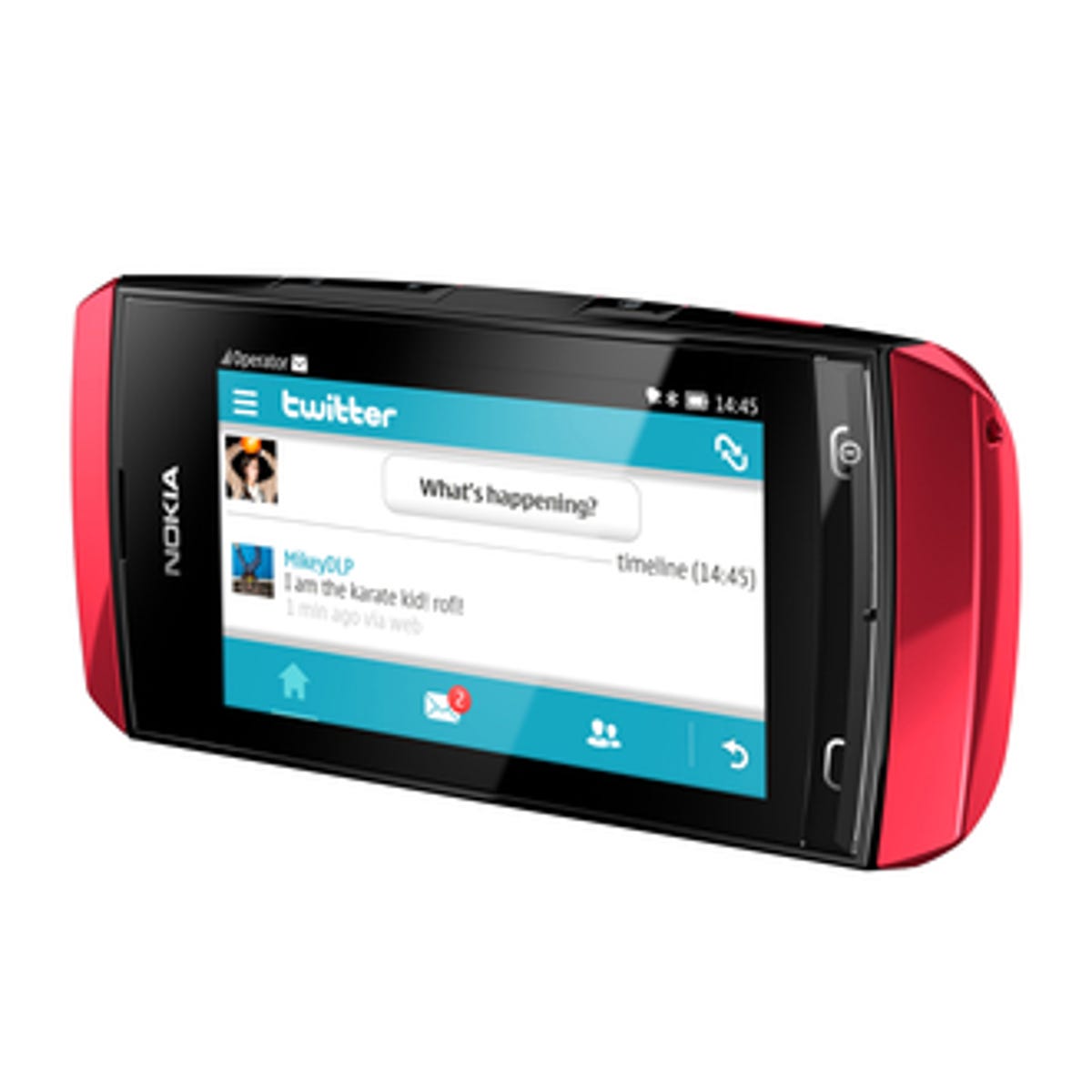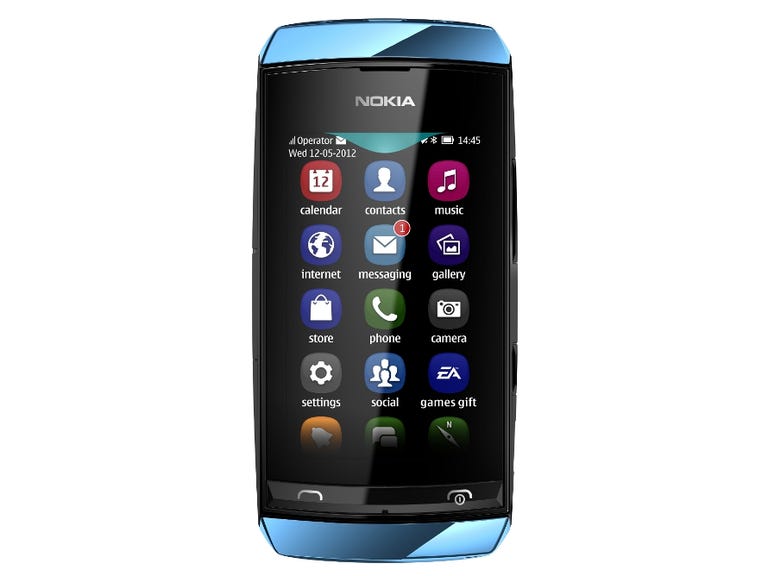 Why You Can Trust CNET
Why You Can Trust CNET Nokia Asha 306 review: Nokia Asha 306
The Nokia Asha 306 is a very basic smart phone but its biggest shortcoming is no 3G, which throttles web speeds away from Wi-Fi. Doh!
Nokia reserves the razzle-dazzle for its Windows Phone-powered Lumia handsets, but the once Mighty Finn is still plugging away selling a cheaper range of Asha phones, based on its old-as-the-hills Series 40 software.
The Good
The Bad
The Bottom Line
Asha phones are mostly aimed at buyers in developing countries such as India, but Nokia's also selling select models here in the UK in the hope of wooing you away from budget Google Android handsets.
They can be described as smart phones with usability strings attached.
Yes, you can download apps but don't expect this software to be as slick
and easy to use as an Android or iOS device.
The Asha 306 has a low price -- currently it's up for grabs SIM-free for £80 via Expansys -- but is it worth even that modest amount of cash?
Should I buy the Asha 306?
In a word, no. The 306 is Nokia's second all-touchscreen Asha offered in the UK, along with the Asha 311. But unlike the latter device it lacks 3G, which kills its usefulness for web browsing when out and about.
There's no sensible reason to buy the 306. Even if money's tight, you're spoiled for choice with so many capable budget Androids up for grabs. This smorgasbord of cheap 'droids means you can bag something far tastier such as the T-Mobile Vivacity, which packs 3G, apps galore and puts simple-to-use software under your fingertips for the same (and even less) cash.
Buying the 306 saddles you with a frustrating, flaky operating system, a cramped low-res screen and crawlingly slow web browsing when not tethered to Wi-Fi. It's like taking 10 steps backwards into the olden days of mobile.
If you're eyeing the 306 as a back-up blower to use in emergencies when your main phone goes kaput, it's still not worth your while as there are more affordable alternatives -- such as Nokia's even cheaper Asha 201 -- to stick in your drawer.
Screen, design and build quality
The 306 is a small, plasticky candybar-shaped handset with a narrow 3-inch touchscreen on its face. The display is very low res at 240x400 pixels -- so it looks hazy and lacks crispness, while the touchscreen feels dull rather than responsive. I found I needed to press firmly to get my fingers to register.

From the front, the phone is all angular edges, as if someone has grabbed a knife and sliced random bits off. Mixed in with the chopped lines are swoops and curves -- especially on the sides and back. There's also a mix of shiny and matte plastic surfaces. The result is a hodge-podge of angles, curves and annoying reflections.
Build quality feels rigid, despite all the plastic, though it's possible you may hear a creak or two if you squeeze the phone really hard.
There are four physical keys on the 306 -- two call buttons on the front incorporated into one long button (the decline call key also doubles as the power key), and a lock key and volume rocker on the right edge.
Ports wise you get a 3.5mm headphone jack, Nokia's proprietary charger port and micro-USB port on the top of the phone (for easily transferring files to and from a PC), and also a microSD card slot handily sited on the left edge of the exterior, underneath a little plastic flap. I found it really hard to get cards out of this though, so you may need to keep a pair of tweezers handy if you plan on doing a lot of card swapping.
The 306's backplate can be removed to get at the 1,110mAh battery and, tucked underneath it, the SIM slot.
Nokia reckons you can get up to 14 hours of talk time from the 306's cell, and up to 400 hours on standby. I found the phone would easily last a day's general use and even longer before needing to be juiced.
Software and apps
The Asha 306 runs Nokia's Series 40 operating system. It's a very old OS that's had a spit and polish to improve usability. Swipe to get past the lock screen and you land on a scrollable screen of friendly-looking rounded icons showing you all the apps on the phone.
Scroll up and down to view apps, or swipe right to get direct to a dialler screen or left to get to another home screen, which you can customise with your favourite apps and contacts to make them easier to access.
This surface simplicity is only skin deep. Under it lurks legacy complexity -- with dialogue boxes all too often popping up to impart cryptic error missives or, annoyingly, asking you to confirm the thing you've just tried to do. This is how mobile OSes used to be in the bad old days.
Fortunately, there are much more elegant and easy-to-use rival OSes out there now, so there's really no need to struggle along with Series 40 unless you're a longtime fan.
Even if you're already well versed in S40, you'll surely still be annoyed by the frequency with which the 306 gets flustered and throws up error messages. I had various connectivity troubles when trying to use the web browser and setting up email on the phone -- finding it not only fiddly, but flaky too. Not a great combo.
If you're wondering about apps, you get some pre-loaded on the phone such as a Twitter app and Nokia's Social app, which gathers updates from different social services into one place. There's also the Nokia Maps app, which I found very slow and clunky on what is clearly a super-low powered blower.
There's no Angry Birds game pre-loaded on the 306, as there is on the 311, but as with the 311, you can download up to 40 EA games free via the EA Games Gift app that's on the phone. You have to download these manually and do so within 60 days of first opening the app.
More apps can be downloaded from Nokia's Ovi store but the 306's weak processor means your choice is limited to apps that aren't too taxing, while the small low-res screen puts further constraints on what will and won't work well.
Hardware and performance
The 306 lacks 3G -- having only a 2G radio in it -- so don't expect fast web browsing when you're not using Wi-Fi. It's crawlingly slow in comparison to 3G blowers. And if you're trying to log onto a gated Wi-Fi network, don't expect it to be a smooth ride. The 306 refused to play well with our office Wi-Fi -- perpetually stalling at the redirect page.
I was able to log onto my home Wi-Fi without a problem. But even on a fast Wi-Fi connection, the phone is still a sluggish and plodding web browser. The tiny screen means you're best off sticking to mobile versions of websites.
Nokia hasn't specified what size processor lurks inside the 306 but it's certainly not the 1GHz sitting in the 311. Performance is noticeably slower than the 311. This weak chip probably explains why there's no Angry Birds.
You'll definitely need bags of patience to own the 306, coupled with extremely modest mobile needs. If you're after a super-basic device that can function as a telephone and has a few games pre-loaded, then the 306 might tick a box. Just be aware there are far slicker 'droids that can deliver all that and much more for the same or less money.
On the back of the 306, Nokia has slapped a 2-megapixel camera but no flash. Like the rest of the 306's software, the camera interface is noticeably laggy, so expect to wait more than a second between pushing the shutter and it taking the snap.
Photo results aren't going to impress anyone, with shots coming out looking wishy-washy and grainy. But for really basic snaps, the 306 is technically capable, provided it's not too dark when you want to get snapping.
Likewise, while the 306 can record video, the quality of the footage is good enough for a quick YouTube clip and nothing else.
The back of the phone sports a speaker that pumps up noise surprisingly loud for such a little phone.
I found call quality to be slightly crackly during testing but it's possible that was down to network issues. The audio certainly didn't sound especially clear or crisp.
Conclusion
The Asha 306 is a very basic kind of smart phone but it's biggest shortcoming is not having 3G, which throttles web browsing speeds when you're out and about. If you're a fan of Nokia's Series 40 software and like the look of its all-touch Ashas, you're better off plumping for the 311, which has 3G and a more powerful chip.
The other big problem hampering the Asha 306 is its price. It's just not cheap enough to be competitive with the best budget Android phones. While £80 sounds cheap, you can bag a decent entry-level 'droid for even less, so there's no sensible reason to saddle yourself with this handset.


